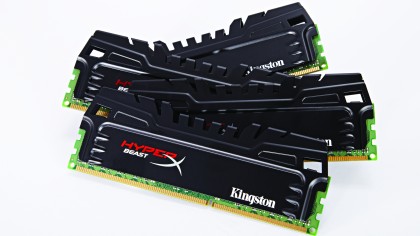Everything you need to know about upgrading your RAM
Our first tests deployed the bare minimum of sluggish DDR3: 8GB of RAM clocked to 1,333MHz. With this RAM, the PC returned scores of 5,170, 6,794, and 5,234 points, in the Home, Creative and Work tests, respectively.
However, with 8GB of 1,600MHz memory deployed, the scores barely improved, with the Creative run only jumping to 6,852. There wasn't even much of a difference in these tests when we installed 16GB of 1,866MHz memory: in those three benchmarks, the machine scored 5,270, 6,961, and 2,525.
The biggest leap came in the Creative test, which suggests more memory helps with photo editing and other trickier tasks, but it's hardly a game-changing jump in performance.

We saw similarly modest gains in other photo-related applications. GigaPan Stitch knits together a group of high-resolution photos, and our test image took four minutes and 12 seconds to complete in a PC with 8GB of 1,333MHz memory.
That only improved by 11 seconds when we doubled the RAM and upped its speed to 1,866MHz.
Modest impacts
Other application benchmarks we did saw similarly modest impacts. A Cinebench R15 CPU test with two 4GB, 1,600MHz sticks returned a result of 703 – doubling the memory and improving its speed to 1,866MHz only improved that figure to 751.
We only saw big improvements in a few benchmarks when running DDR3 tests. In PCMark Vantage, our 8GB 1,600MHz PC scored 18,313 points. But doubling the memory and running it at 1,866MHz saw that result jump by almost 3,000 points - a significant increase.
Sign up for breaking news, reviews, opinion, top tech deals, and more.

Indeed, our theoretical tests indicate that improving memory amounts and speeds does make a difference, but that these performance gains don't generally translate to real-world tests.
In SiSoft Sandra's multithreaded bandwidth test, our 2x 4GB 1,333MHz setup scored 16.57GB/s, but doubling the memory and improving its speed to 1,866MHz saw that result jump to 23.33GB/s. There was a decent jump in single-threaded bandwidth, and we also found cache bandwidth also improved significantly when faster memory was added in larger amounts.
The leap from dual-channel to quad-channel memory doesn't often have much of an impact on our application tests, either. In Cinebench R15's OpenGL test, a machine with two 4GB 1,600MHz sticks scored 111 frames per second, with this score only jumping to 117fps with four 4GB 1,600MHz sticks installed.
When running applications using DDR3, then, the differences between slow and fast memory often aren't huge – and, as long as you've got 8GB of memory installed, then you're going to have enough to get most stuff done in real-world situations.
There was a noticeable performance difference between our PC with 1,333MHz and 1,600MHz memory installed. But once beyond that 1,600MHz speed, the gaps between different memory speeds narrowed rapidly. We ran GeekBench single-core benchmark on 1,600MHz memory, and then again at 2,800MHz memory, but its result only improved by around 100 points.
The benchmarks demonstrate that there are performance gains to be had by installing more memory at faster speeds, but those gains are only noticeable in high-end applications. For most of us, 8GB or 16GB of 1,866MHz memory will be more than enough for our purposes.
Mike has worked as a technology journalist for more than a decade and has written for most of the UK’s big technology titles alongside numerous global outlets. He loves PCs, laptops and any new hardware, and covers everything from the latest business trends to high-end gaming gear.